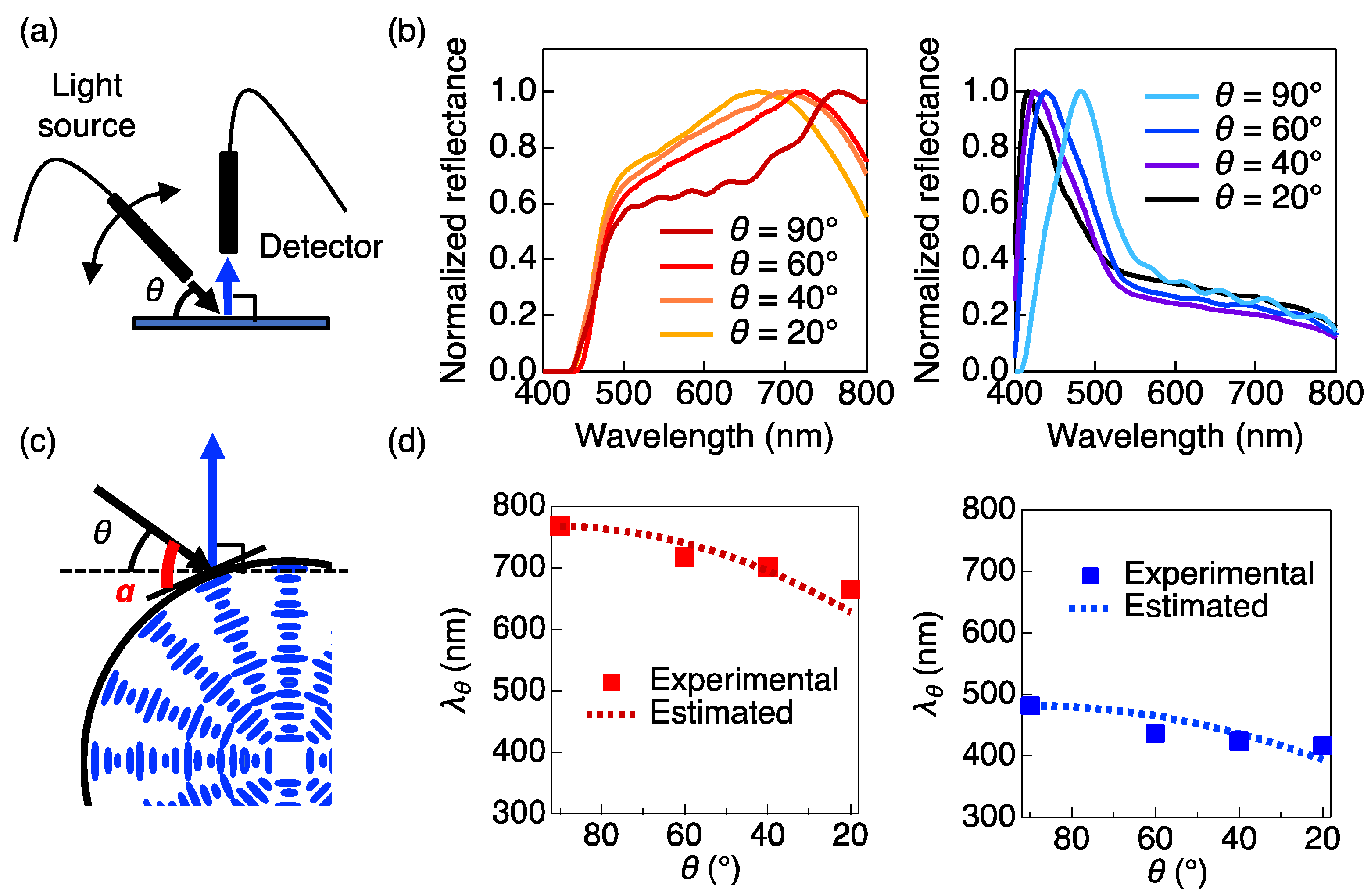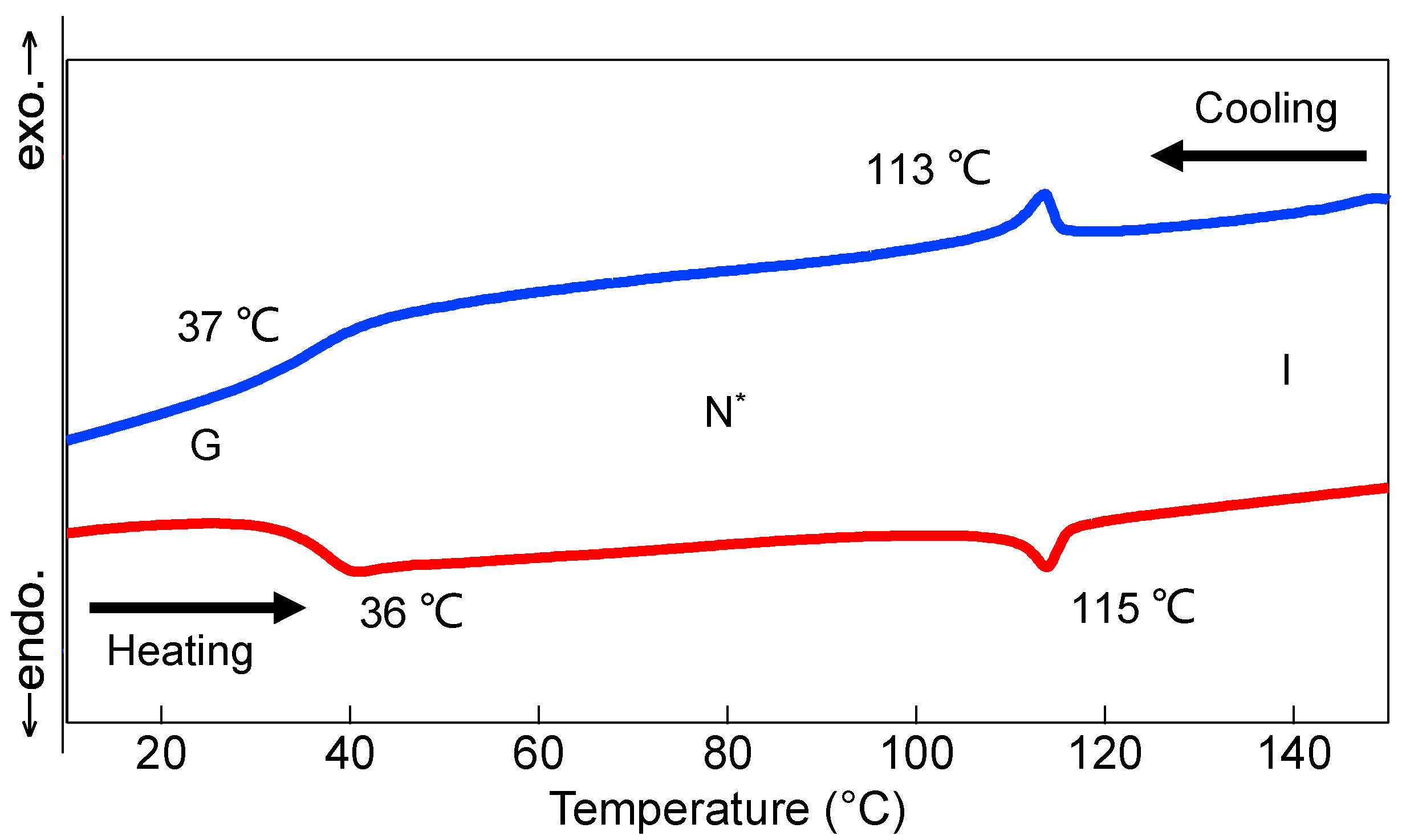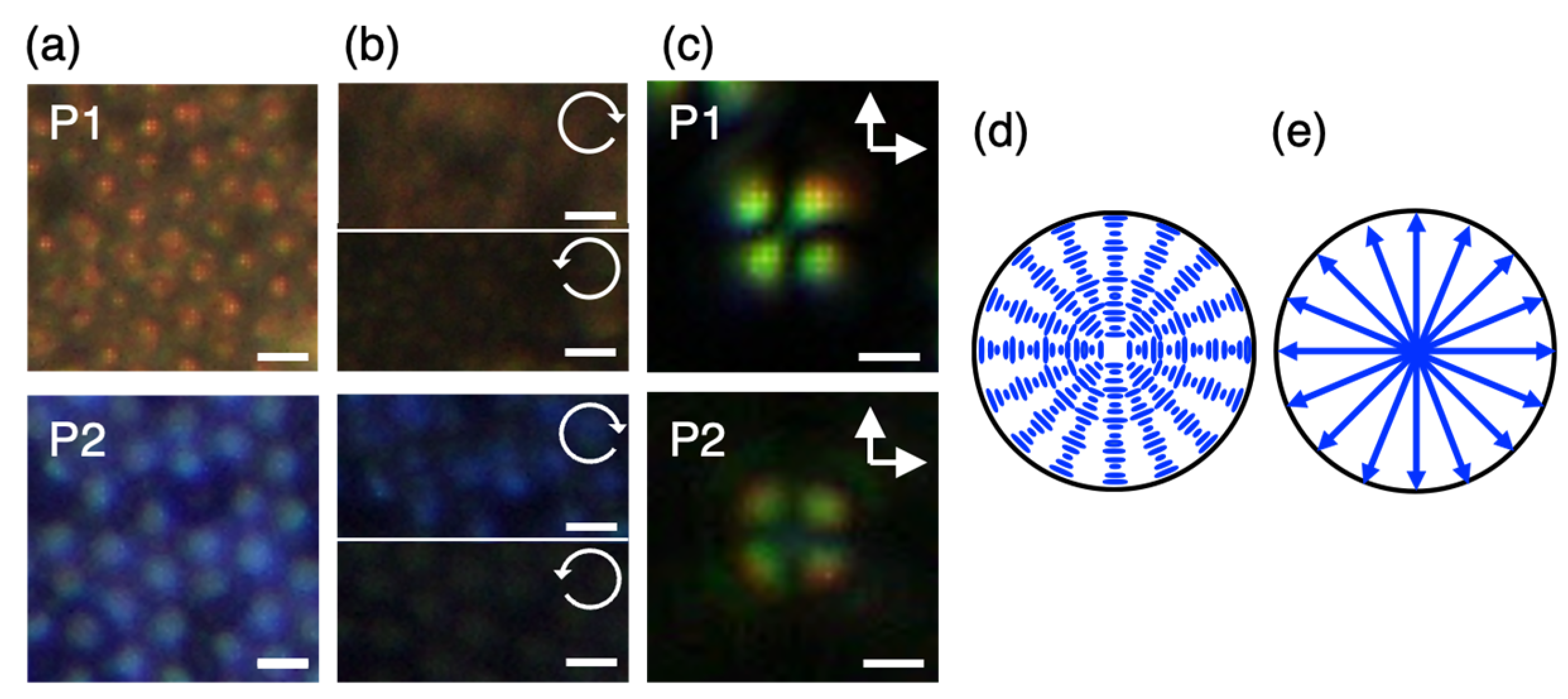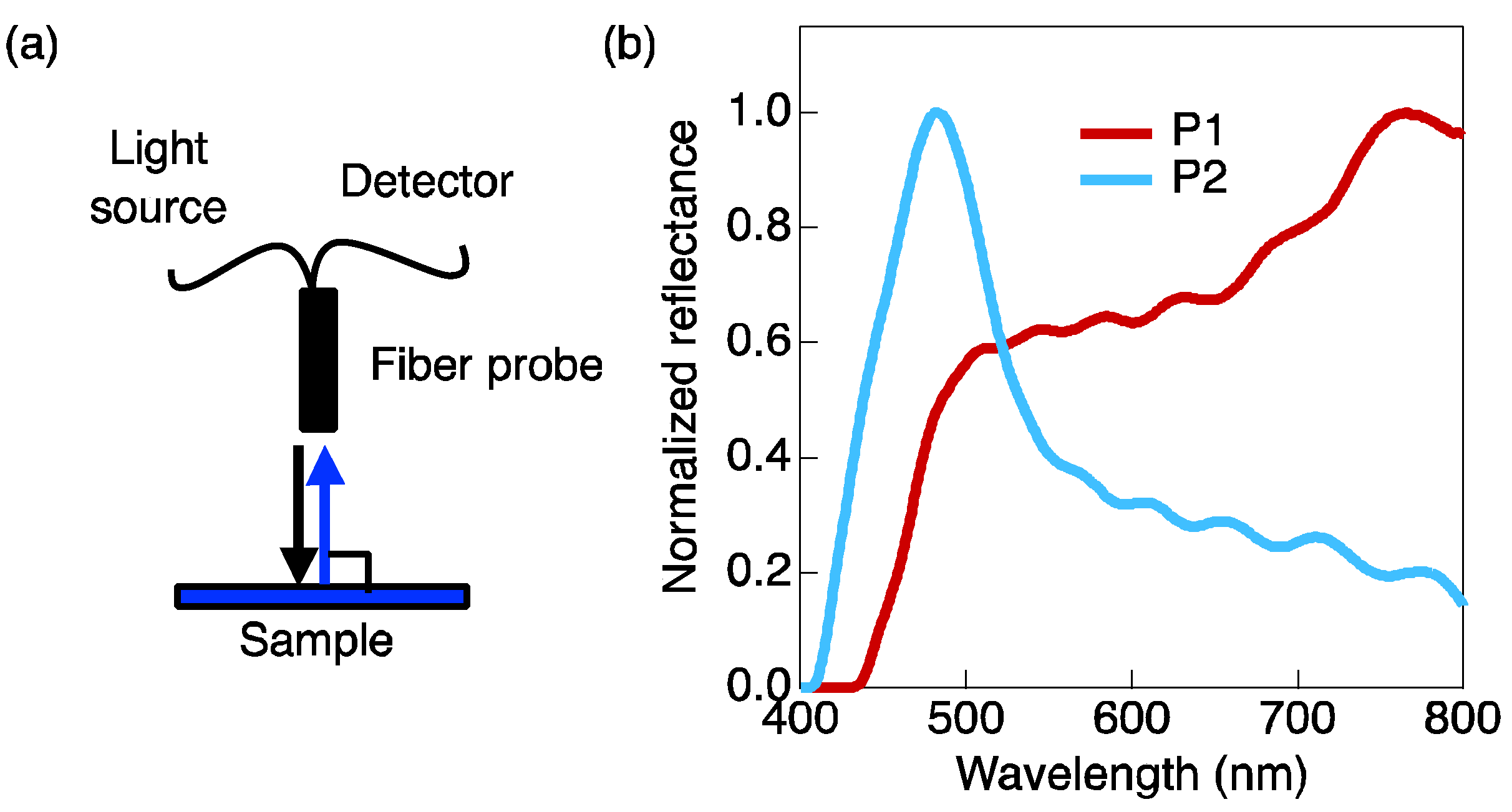Angular-Dependent Back-Reflection of Chiral-Nematic Liquid Crystal Microparticles as Multifunctional Optical Elements
Abstract
:1. Introduction
2. Materials and Methods
2.1. Preparation of N* LC Particles Using Dispersion Polymerization
2.2. Characterization of N* LC Particles
2.3. Evaluation of Reflection Functionalities
3. Results and Discussion
3.1. Synthesis and Characterization of N* LC Polymer Particles
3.2. Retro-Reflection Behavior
3.3. Optical Functionalities under Different Incidence Angles

4. Conclusions
5. Patents
Supplementary Materials
Author Contributions
Funding
Data Availability Statement
Acknowledgments
Conflicts of Interest
References
- Li, L.; Bryant, D.; Bos, P.J. Broadband Liquid crystal lens with concentric electrodes and inter-electrode resistors. Liq. Cryst. Rev. 2014, 2, 130–154. [Google Scholar] [CrossRef]
- Ishiguro, M.; Sato, D.; Shishido, A.; Ikeda, T. Bragg-Type Polarization Gratings Formed in Thick Polymer Films Containing Azobenzene and Tolane Moieties. Langmuir 2007, 23, 332–338. [Google Scholar] [CrossRef]
- Provenzano, C.; Pagliusi, P.; Cipparrone, G. Highly Efficient Liquid Crystal Based Diffraction Grating Induced by Polarization Holograms at the Aligning Surfaces. Appl. Phys. Lett. 2006, 89, 121105. [Google Scholar] [CrossRef]
- Foelen, Y.; Schenning, A.P.H.J. Optical Indicators Based on Structural Colored Polymers. Adv. Sci. 2022, 9, 2200399. [Google Scholar] [CrossRef] [PubMed]
- Eichert, D.; Gregoratti, L.; Kaulich, B.; Marcello, A.; Melpignano, P.; Quaroni, L.; Kiskinova, M. Imaging with Spectroscopic Micro-Analysis Using Synchrotron Radiation. Anal. Bioanal. Chem. 2007, 389, 1121–1132. [Google Scholar] [CrossRef] [PubMed]
- Ferreira, M.F.S.; Castro-Camus, E.; Ottaway, D.J.; López-Higuera, J.M.; Feng, X.; Jin, W.; Jeong, Y.; Picqué, N.; Tong, L.; Reinhard, B.M. Roadmap on Optical Sensors. J. Opt. 2017, 19, 083001. [Google Scholar] [CrossRef]
- Zhu, X.; Xia, Y.; Wang, X.; Si, K.; Gong, W. Optical Brain Imaging: A Powerful Tool for Neuroscience. Neurosci. Bull. 2017, 33, 95–102. [Google Scholar] [CrossRef]
- Talbot, B.; Astrup, R. A Review of Sensors, Sensor-Platforms and Methods Used in 3D Modelling of Soil Displacement after Timber Harvesting. Croat. J. For. Eng. 2021, 42, 149–164. [Google Scholar] [CrossRef]
- Raj, T.; Hashim, F.H.; Huddin, A.B.; Ibrahim, M.F.; Hussain, A. A Survey on LiDAR Scanning Mechanisms. Electronics 2020, 9, 741. [Google Scholar] [CrossRef]
- Shanks, K.; Senthilarasu, S.; Mallick, T.K. Optics for Concentrating Photovoltaics: Trends, Limits and Opportunities for Materials and Design. Renew. Sustain. Energy Rev. 2016, 60, 394–407. [Google Scholar] [CrossRef]
- Kobashi, J.; Yoshida, H.; Ozaki, M. Planar Optics with Patterned Chiral Liquid Crystals. Nat. Photonics 2016, 10, 389–392. [Google Scholar] [CrossRef]
- Yue, Y.; Kurokawa, T.; Haque, M.A.; Nakajima, T.; Nonoyama, T.; Li, X.; Kajiwara, I.; Gong, J.P. Mechano-Actuated Ultrafast Full-Colour Switching in Layered Photonic Hydrogels. Nat. Commun. 2014, 5, 4659. [Google Scholar] [CrossRef] [PubMed]
- Kim, D.Y.; Nah, C.; Kang, S.W.; Lee, S.H.; Lee, K.M.; White, T.J.; Jeong, K.U. Free-Standing and Circular-Polarizing Chirophotonic Crystal Reflectors: Photopolymerization of Helical Nanostructures. ACS Nano 2016, 10, 9570–9576. [Google Scholar] [CrossRef]
- Chen, P.; Ma, L.L.; Duan, W.; Chen, J.; Ge, S.J.; Zhu, Z.H.; Tang, M.J.; Xu, R.; Gao, W.; Li, T. Digitalizing Self-Assembled Chiral Superstructures for Optical Vortex Processing. Adv. Mater. 2018, 30, 1705865. [Google Scholar] [CrossRef]
- Hisano, K.; Kimura, S.; Ku, K.; Shigeyama, T.; Akamatsu, N.; Shishido, A.; Tsutsumi, O. Mechano-Optical Sensors Fabricated with Multilayered Liquid Crystal Elastomers Exhibiting Tunable Deformation Recovery. Adv. Funct. Mater. 2021, 31, 2104702. [Google Scholar] [CrossRef]
- White, T.J.; McConney, M.E.; Bunning, T.J. Dynamic Color in Stimuli-Responsive Cholesteric Liquid Crystals. J. Mater. Chem. 2010, 20, 9832–9847. [Google Scholar] [CrossRef]
- Mitov, M. Cholesteric Liquid Crystals with a Broad Light Reflection Band. Adv. Mater. 2012, 24, 6260–6276. [Google Scholar] [CrossRef]
- Shin, S.; Park, M.; Ku Cho, J.; Char, J.; Gong, M.; Jeong, K.U. Tuning Helical Twisting Power of Isosorbide-Based Chiral Dopants by Chemical Modifications. Mol. Cryst. Liq. Cryst. 2011, 534, 19–31. [Google Scholar] [CrossRef]
- Shigeyama, T.; Hisano, K.; Tsutsumi, O. Control of Helical-Axis Orientation of Chiral Liquid Crystals in Monodispersed Polymer Particles. Proc. SPIE 2021, 11807, 118070F. [Google Scholar] [CrossRef]
- Shigeyama, T.; Hisano, K.; Matsumoto, K.; Tsutsumi, O. Tunable Reflection through Size Polydispersity of Chiral-Nematic Liquid Crystal Polymer Particles. Molecules 2023, 28, 7779. [Google Scholar] [CrossRef]
- Kawaguchi, S.; Ito, K. Dispersion Polymerization. Adv. Polym. Sci. 2005, 175, 299–328. [Google Scholar] [CrossRef]
- Paine, A.J.; Luymes, W.; McNulty, J. Dispersion Polymerization of Styrene in Polar Solvents. 6. Influence of Reaction Parameters on Particle Size and Molecular Weight in Poly(N-Vinylpyrrolidone)-Stabilized Reactions. Macromolecules 1990, 23, 3104–3109. [Google Scholar] [CrossRef]
- Chen, H.Q.; Wang, X.Y.; Bisoyi, H.K.; Chen, L.J.; Li, Q. Liquid Crystals in Curved Confined Geometries: Microfluidics Bring New Capabilities for Photonic Applications and Beyond. Langmuir 2021, 37, 3789–3807. [Google Scholar] [CrossRef] [PubMed]
- Balenko, N.; Shibaev, V.; Bobrovsky, A. Mechanosensitive polymer-dispersed cholesteric liquid crystal composites based on various polymer matrices. Polymer 2023, 281, 126119. [Google Scholar] [CrossRef]
- Pan, Y.; Xie, S.; Wang, H.; Huang, L.; Shen, S.; Deng, Y.; Ma, Q.; Liu, Z.; Zhang, M.; Jin, M.; et al. Microfluidic Construction of Responsive Photonic Microcapsules of Cholesteric Liquid Crystal for Colorimetric Temperature Microsensors. Adv. Opt. Mater. 2023, 11, 2202141. [Google Scholar] [CrossRef]
- Froyen, A.A.F.; Debije, M.G.; Schenning, A.P.H.J. Polymer Dispersed Cholesteric Liquid Crystal Mixtures for Optical Time–Temperature Integrators. Adv. Opt. Mater. 2022, 10, 2201648. [Google Scholar] [CrossRef]
- Agha, H.; Zhang, Y.S.; Geng, Y.; Lagerwall, J.P.F. Pixelating Structural Color with Cholesteric Spherical Reflectors. Adv. Photonics Res. 2023, 4, 2200363. [Google Scholar] [CrossRef]
- Ku, K.; Hisano, K.; Kimura, S.; Shigeyama, T.; Akamatsu, N.; Shishido, A.; Tsutsumi, O. Environmentally Stable Chiral-nematic Liquid-crystal Elastomers with Mechano-optical Properties. Appl. Sci. 2021, 11, 5037. [Google Scholar] [CrossRef]
- Jiang, P.; Bertone, J.F.; Hwang, K.S.; Colvin, V.L. Single-Crystal Colloidal Multilayers of Controlled Thickness. Chem. Mater. 1999, 11, 2132–2140. [Google Scholar] [CrossRef]
- Mamuk, A.E.; Nesrullajev, A.; Mukherjee, P.K. Refractive and Birefringent Properties of 4-Alkyl-4′-Oxycyanobiphenyls at Direct and Reverse Phase Transitions. Mol. Cryst. Liq. Cryst. 2017, 648, 168–181. [Google Scholar] [CrossRef]
- Noh, J.H.; Liang, H.-L.; Olenikcd, I.D.; Lagerwall, J.P.F. Tuneable multicoloured patterns from photonic cross-communication between cholesteric liquid crystal droplets. J. Mater. Chem. C 2014, 2, 806–810. [Google Scholar] [CrossRef]
- He, J.; Liu, S.; Gao, G.; Sakai, M.; Hara, M.; Nakamura, Y.; Kishida, H.; Seki, T.; Takeoka, Y. Particle Size Controlled Chiral Structural Color of Monodisperse Cholesteric Liquid Crystals Particles. Adv. Opt. Mater. 2023, 11, 2300296. [Google Scholar] [CrossRef]
- Humar, M.; Muševič, I.; Sullivan, K.G.; Hall, D.G. 3D Microlasers from Self-Assembled Cholesteric Liquid-Crystal Microdroplets. Opt. Express 2010, 18, 26995–27003. [Google Scholar] [CrossRef] [PubMed]
- Fan, J.; Li, Y.; Bisoyi, H.K.; Zola, R.S.; Yang, D.; Bunning, T.J.; Weitz, D.A.; Li, Q. Light-Directing Omnidirectional Circularly Polarized Reflection from Liquid-Crystal Droplets. Angew. Chem. Int. Ed. 2015, 54, 2160–2164. [Google Scholar] [CrossRef] [PubMed]
- Belmonte, A.; Pilz da Cunha, M.; Nickmans, K.; Schenning, A.P.H.J. Brush-Paintable, Temperature and Light Responsive Triple Shape-Memory Photonic Coatings Based on Micrometer-Sized Cholesteric Liquid Crystal Polymer Particles. Adv. Opt. Mater. 2020, 8, 2000054. [Google Scholar] [CrossRef]
- Belmonte, A.; Ussembayev, Y.Y.; Bus, T.; Nys, I.; Neyts, K.; Schenning, A.P.H.J. Dual Light and Temperature Responsive Micrometer-Sized Structural Color Actuators. Small 2020, 16, 1905219. [Google Scholar] [CrossRef]




| Particle | Molar ratio of CM (mol%) | d (µm) | Mn (Mw/Mn) | Tg (°C) |
|---|---|---|---|---|
| P1 | 2.4 | 2.5 | 15,000 (2.6) | 36 |
| P2 | 3.8 | 2.6 | 15,000 (2.6) | 37 |
Disclaimer/Publisher’s Note: The statements, opinions and data contained in all publications are solely those of the individual author(s) and contributor(s) and not of MDPI and/or the editor(s). MDPI and/or the editor(s) disclaim responsibility for any injury to people or property resulting from any ideas, methods, instructions or products referred to in the content. |
© 2023 by the authors. Licensee MDPI, Basel, Switzerland. This article is an open access article distributed under the terms and conditions of the Creative Commons Attribution (CC BY) license (https://creativecommons.org/licenses/by/4.0/).
Share and Cite
Shigeyama, T.; Matsumoto, K.; Hisano, K.; Tsutsumi, O. Angular-Dependent Back-Reflection of Chiral-Nematic Liquid Crystal Microparticles as Multifunctional Optical Elements. Crystals 2023, 13, 1660. https://doi.org/10.3390/cryst13121660
Shigeyama T, Matsumoto K, Hisano K, Tsutsumi O. Angular-Dependent Back-Reflection of Chiral-Nematic Liquid Crystal Microparticles as Multifunctional Optical Elements. Crystals. 2023; 13(12):1660. https://doi.org/10.3390/cryst13121660
Chicago/Turabian StyleShigeyama, Tomoki, Kohsuke Matsumoto, Kyohei Hisano, and Osamu Tsutsumi. 2023. "Angular-Dependent Back-Reflection of Chiral-Nematic Liquid Crystal Microparticles as Multifunctional Optical Elements" Crystals 13, no. 12: 1660. https://doi.org/10.3390/cryst13121660






